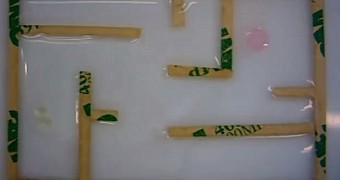Forget Harry Potter and tales about witches turning people into frogs. Science is cooler than stories about magic could ever hope to be, and researchers with the University of Southern Denmark and the Czech Republic's Institute of Chemical Technology have proof.
In a recent paper, these brainiacs detail how, using nothing but salt, they managed to convince alcohol droplets to navigate a fairly complex water maze on their own.
What's more, they argue that, all things considered, it might one day be possible to use such droplets with a mind of their own to deliver medicine to very specific targets.
Getting alcohol droplets to move
Ask any cocktails enthusiast, and they will tell you that alcohol does possess a certain kind of magic. The magic that the University of Southern Denmark and Institute of Chemical Technology scientists toyed with is its adoration for salt.
As detailed by principal investigator Martin Hanczyc, alcohol is attracted to salt. Hence, when alcohol droplets were introduced into a water maze that accommodated for a salty environment at one end, they moved towards it.
The researchers carried out several experiments, and were courteous enough to share a video of one of them with the general public. The footage is available below, and it shows an alcohol droplet navigating the maze in search of salt.
“Salt is the stimulus that makes them move. They move because the salt gradient provides a different energy landscape. It is like taking a ball that is laying still on a flat surface and then suddenly make the surface hilly,” scientist Martin Hanczyc explained the behavior of the alcohol droplet.
“Without a salt gradient every direction in which a droplet might move looks the same (i.e. flat). But with a salt gradient coming from one direction the droplet can move energetically downhill into the salt gradient,” the specialist went on to add.
According to Martin Hanczyc and fellow researchers, the more salt there is in a given environment, the more desperate to reach it alcohol droplets are. By being aware of this preference of theirs, it is possible to control their behavior and get them to move as if they were living organisms.
Potential uses of this simple system
As mentioned, the scientists behind this research project imagine using alcohol's attraction towards salt to develop a new technology that boils down to using droplets to deliver medicine to very specific regions. Having arrived at their destination, the droplets would release the medicine.
“For example, the droplet can act either as a lubricant, targeting an area that needs lubrication. Or the droplet can act as a carrier for chemistry that can find a target destination and release its content, such as flavoring, medicine etc.,” Martin Hanczyc said in a statement.
Admittedly, it will probably be a while until scientists find a way to use such life-like droplets to carry medicine and other compounds. Still, this does not change the fact that, as proven by this series of experiments, the ability to be self-moving is not restricted to living organisms.

 14 DAY TRIAL //
14 DAY TRIAL // 